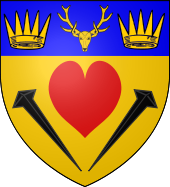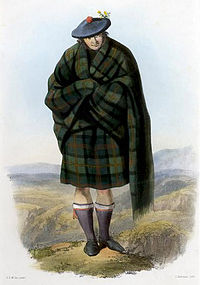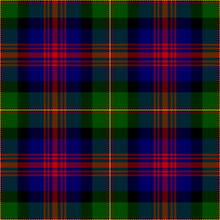- Clan MacLennan
-
Clan MacLennan Crest badge Crest: A demi-piper all Proper, garbed in the proper tartan of the Clan MacLennan.[1] Motto: Dum spiro spero[1] Profile Plant badge Furze[2] Chief

Ruairidh Donald George MacLennan of MacLennan[3] The Chief of the Name and Arms of MacLennan[3] Clan MacLennan, also known as Siol Ghillinnein,[2] is a Highland Scottish clan which historically populated lands in the north-west of Scotland. The surname MacLennan in Scottish Gaelic is Mac Gille Fhinnein meaning the son of the follower of St Finnan.
Contents
History
 A Victorian era, romanticised depiction of a member of the clan by R. R. McIan, from The Clans of the Scottish Highlands, published in 1845.
A Victorian era, romanticised depiction of a member of the clan by R. R. McIan, from The Clans of the Scottish Highlands, published in 1845.
Origins
According to tradition the clans MacLennan and Logan are related. In the fifteenth century a feud between the clans Logan and Fraser ended in a battle at North Kessock, in which the Clan Logan chief, Gilligorm, was killed. Gilligorm's pregnant widow was captured by the Frasers and soon gave birth to a child.[2] The Frasers intentionally broke the child's back,[4] who was named Crotair MacGilligorm because of his deformity.[2]
Crotair MacGilligorm was educated by the monks at Beauly Priory[2] and later founded churches at Kilmor, Sleat and Kilchrinin, Glenelg. His son, called Gille Fhinnein, is the supposed progenitor of the Clan MacLennan.[4]
In the 1970s, research by the clan chief showed that the his ancestry could be traced back to the ancient royal Celtic families of Ireland and Scotland through Aengus Macgillafinan, Lord of Locherne around 1230.[5]
St. Adamans recorded they were occupying Glenshiel at an early date and were in residence at Eilean Donnan Castle before 1263. They spread to Strathearn in Perthshire, Kirkcudbright, Dumbarton and Galloway. In Kintail, they lived with their kin, the MacRuairis, who were granted ten davochs of Kintail by King David II of Scotland in 1342. After successful raids on Tain and Chanonry in 1372 the clan suffered reprisal attacks by the Clan Fraser and Clan Macrae of Aird at Drumderfit, Black Isle.[6]
15th century
The Maclennans settled around Kintail, and they were related to the Clan Logan, who also held lands in Easter Ross. (The Logans were to become most prominent in the Lowlands, where they became Barons of Restalrig, near the Port of Leith). The Clan MacLennan like the Clan Macrae were staunch supporters of the Clan Mackenzie of Kintail whose chief held power in the area of Kintail. Neither were septs of the Mackenzies but they both appear to have held the position of honourable and valued allies. However, other historians have suggested that the original name of the clan was Logan, and that it was not until the fifteenth century that the name Maclennan was adopted.[7]
Battle of Bealach nam Broig. 1452. The Clan McLennan and their allies were overwhelmed in the Great Battle of Bealach nam Broig in 1452. "A desperate skirmish, which took place some time before this, at Bealach nam Broig, "betwixt the heights of Fearann Donuil and Lochbraon," was brought about by some of Kintail's vassals, instigated by Donald Garbh Maciver attempting to seize the Earl of Ross, but the plot having being discovered, Maciver was seized by the Earl of Ross, Lord of the Isles' followers, and imprisoned in Dingwall. He was soon releawsed, however, by his undaunted countrymen from Kenlochewe, followers of MacKenzie of Kintial, consisting of Macivers, Maclennans, Macaulays, and Macleays, who, by way of reprisal, pursued and seized the Earl's son at Balnagown, and carried him along with them. His father, Earl John, at once apprised the Lord Lovat, who was then His Majesty's Lieutenant in the North, of the illegal seizure of his son, and he at once dispatched sic northward two hundred men, who, joined by Ross's vassals, the Munros of Fowlis, and the Dingwalls of Kildun, pursued and overtook the western tribes at Bealach nam Broig, where they were resting themselves. A desperate and bloody conflict ensued, aggravated and exasperated by a keen and bitter recollection of ancient feud and animosities. The Kenlochewe men (Macivers, Maclennans, Macaulays, and Macleays) seem to have been completely extirpated and defeated. The race of Dingwall was actually extinguished, one hundred and forty of their men having been slain, and the Munro family of Fowlis although rescuing the hostage, lost eleven members of their house alone, with many of the leading men of their clan.[8]
17th century
During the Civil War the MacLennans followed the Mackenzies who were on the Covenanter side. The Mackenzie chief was now the self proclaimed Lord Seaforth. They fought against James Graham the 1st Marquess of Montrose who was the commander of the Royalist forces in Scotland at the Battle of Auldearn in 1645. The Clan MacLennan were led by their chief Ruaridh, a red-bearded giant standing well over six feet tall.[9]
James Graham the Marquess of Montrose was heavily outnumbered but his strategic genius more than compensated for it. He massed his banners, hoping to deceive the enemy as to the location of his main force. The ruse succeeded, forcing the Covenanters to mass their forces for a full assault. Graham the Marquess of Montrose outflanked Lord Mackenzie of Seaforth, turning the tide of battle in his favour. The Maclennans were sent an order to withdraw, but it was never delivered. Ruaridh and his men fought to the last, defending Seaforth’s standard. They were finally cut down by the Clan Gordon cavalry.[10]
Clan MacLennan today
In 1977, the Lord Lyon King of Arms recognised Ronald MacLennan as the 'Chief of the Name and Arms of MacLennan'. However, another man, William MacLennan from Sydney, Australia, came forward with proof of his descent, in the male line, from the senior line of the clan. This man's arms were then matriculated by the Lord Lyon King of Arms, yet he did not contest Ronald MacLennan's chiefship despite his senior descent. Both men died in 1990 and the chief's son, aged 13, succeeded his father. The son of William MacLennan, however, still retained the option of to contest the chiefship of the clan.[11]
Clan profile
- Clan chief: The current chief of the clan is Ruairidh Donald George MacLennan of MacLennan, Chief of the Name and Arms of MacLennan.[3]
- Chiefly arms: The current chief's coat of arms is blazoned: Or, a heart of Gules between two passion nails joined in base Sable, on a chief Azure a stag's head cabossed between two antique crowns, all of the First.[13]
- Chief's war cry: Druim nan deur, which translates from Scottish Gaelic as "the ridge of tears".[13]
- Clan member's crest badge: The crest badge suitable for clan members contains the chief's heraldic crest and motto. The crest is: A demi-piper all Proper, garbed in the proper tartan of the Clan MacLennan. The motto is: Dum spiro spero. The motto translates from Latin as "while i breathe i hope".[1]
- Clan badge: The plant badge of Clan MacLennan is furze.[2]
- Clan tartan: Clans MacLennan and Logan share the same tartan.[2]
See also
- Clan Logan, which has been associated with the Clan MacLennan.
References
- ^ a b c George Way of Plean; Squire 2000: p. 214.
- ^ a b c d e f g Bain 1983: pp. 138–139.
- ^ a b c "MacLennan of MacLennan, Chief of MacLennan". Burke's Peerage and Gentry. http://www.burkes-peerage.net/familyhomepage.aspx?FID=0&FN=MACLENNANOFMACLENNAN. Retrieved 22 June 2009.
- ^ a b The Scottish Tartans, With Historical Sketches of the Clans and Families of Scotland, p.87
- ^ "www.myclan.com/clans/MacLennan_88/default.php". http://www.myclan.com/clans/MacLennan_88/default.php.
- ^ "www.highlandtraveller.com/clans/maclennan.html". http://www.highlandtraveller.com/clans/maclennan.html.
- ^ "www.myclan.com/clans/MacLennan_88/default.php". http://www.myclan.com/clans/MacLennan_88/default.php.
- ^ "members.fortunecity.com/kgoofy7/EarlyMaclayHistory.htm#". http://members.fortunecity.com/kgoofy7/EarlyMaclayHistory.htm#.
- ^ "www.clanmaclennan-worldwide.com/gen/history.htm". http://www.clanmaclennan-worldwide.com/gen/history.htm.
- ^ "www.clanmaclennan-worldwide.com/gen/history.htm". http://www.clanmaclennan-worldwide.com/gen/history.htm.
- ^ MacDonald 1995: pp. 145–146.
- ^ Stewart 1974: p. 65.
- ^ a b "Crest, Motto, War Cry, Arms & Tartans". www.clanmaclennan-worldwide.com. http://www.clanmaclennan-worldwide.com/gen/motto.htm. Retrieved 22 June 2009.
Sources
- (194?). The Scottish Tartans, With Historical Sketches of the Clans and Families of Scotland. W & A K Johnston, Ltd. (Edinburgh).
- Bain, Robert (1983). MacDougall, Margaret O. ed. The Clans and Tartans of Scotland. Heraldic advisor Stewart-Blacker, P. E. Glasgow: Collins. ISBN 0 00 411117 6.
- MacDonald, Micheil (1995). The Clans of Scotland, The History and Landscape of the Scottish Clans. London: Grange Books. ISBN 1-85627-749-6.
- Stewart, Donald Calder (1974). The Setts of the Scottish Tartans, with descriptive and historical notes (2nd revised ed.). London: Shepheard-Walwyn. ISBN 0 85603 011 9.
- Way, George; Squire, Romilly (2000). Clans & Tartans. Glasgow: HarperCollins. ISBN 0-00-472501 8.
External links
Scottish clans Clans with chiefs Agnew · Anstruther · Arbuthnott · Arthur · Bannerman · Barclay · Borthwick · Boyd · Boyle · Brodie · Broun · Bruce · Buchan · Burnett · Cameron · Campbell · Carmichael · Carnegie · Cathcart · Charteris · Chattan · Chisholm · Cochrane · Colquhoun · Colville · Cranstoun · Crichton · Cumming · Darroch · Davidson · Dewar · Drummond · Dunbar · Dundas · Durie · Elliot · Elphinstone · Erskine · Farquharson · Fergusson · Forbes · Forsyth · Fraser · Fraser of Lovat · Gayre · Gordon · Graham · Grant · Gregor · Grierson · Guthrie · Haig · Haldane · Hamilton · Hannay · Hay · Henderson · Home · Hope · Hunter · Irvine · Jardine · Johnstone · Keith · Kennedy · Kerr · Kincaid · Lamont · Leask · Lennox · Leslie · Lindsay · Lockhart · Lumsden · Lyon · MacAlister · MacBain · MacDonald · Macdonald of Clanranald · MacDonald of Keppoch · Macdonald of Sleat · MacDonell of Glengarry · MacDougall · Macdowall · MacIntyre · Mackay · Mackenzie · Mackinnon · Mackintosh · Maclachlan · Maclaine of Lochbuie · MacLaren · MacLea (Livingstone) · Maclean · MacLennan · MacLeod · MacLeod of Lewis · MacMillan · Macnab · Macnaghten · MacNeacail · MacNeil · Macpherson · MacTavish · MacThomas · Maitland · Makgill · Malcolm (MacCallum) · Mar · Marjoribanks · Matheson · Menzies · Moffat · Moncreiffe · Montgomery · Morrison · Munro · Murray · Napier · Nesbitt · Nicolson · Ogilvy · Oliphant · Primrose · Ramsay · Rattray · Riddell · Robertson · Rollo · Rose · Ross · Ruthven · Sandilands · Scott · Scrymgeour · Sempill · Shaw · Sinclair · Skene · Spens · Stirling · Strange · Stuart of Bute · Sutherland · Swinton · Trotter · Urquhart · Wallace · Wedderburn · Wemyss · Wood ·
Armigerous clans Abercromby · Abernethy · Adair · Adam · Aikenhead · Ainslie · Aiton · Allardice · Anderson · Armstrong · Arnott · Auchinleck · Baillie · Baird · Balfour · Bannatyne · Baxter · Bell · Belshes · Bethune · Beveridge · Binning · Bissett · Blackadder · Blackstock · Blair · Blane · Blyth · Boswell · Brisbane · Buchanan · Butter · Byres · Cairns · Calder · Caldwell · Callender · Campbell of Breadalbane · Campbell of Cawdor · Carruthers · Cheyne · Chalmers · Clelland · Clephane · Cockburn · Congilton · Craig · Crawford · Crosbie · Cunningham · Dalmahoy · Dalrymple · Dalzell · Dennistoun · Don · Douglas · Duncan · Dunlop · Edmonstone · Fairlie · Falconer · Fenton · Fleming · Fletcher · Forrester · Fotheringham · Fullarton · Galbraith · Galloway · Gardyne · Gartshore · Ged · Gibsone · Gladstains · Glas · Glen · Glendinning · Gray · Gunn · Haliburton · Halkerston · Halket · Hepburn · Heron · Herries · Hogg · Hopkirk · Horsburgh · Houston · Hutton · Inglis · Innes · Kelly · Kinloch · Kinnaird · Kinnear · Kinninmont · Kirkcaldy · Kirkpatrick · Laing · Lammie · Langlands · Learmonth · Little · Logan · Logie · Lundin · Lyle · MacAulay · Macbrayne · MacDuff · MacEwen · MacFarlane · Macfie · Macgillivray · MacInnes · MacIver · Mackie · MacLellan · Macquarrie · Macqueen · Macrae · Masterton · Maule · Maxton · Maxwell · McCorquodale · McCulloch · McKerrell · Meldrum · Melville · Mercer · Middleton · Moncur · Monteith · Monypenny · Mouat · Moubray · Mow · Muir · Murray of Atholl · Nairn · Nevoy · Newlands · Newton · Norvel · Ochterlony · Orrock · Paisley · Paterson · Pennycook · Pentland · Peter · Pitblado · Pitcairn · Pollock · Polwarth · Porterfield · Preston · Pringle · Purves · Rait · Ralston · Renton · Roberton · Rossie · Russell · Rutherford · Schaw · Seton · Skirving · Somerville · Spalding · Spottiswood · Stewart · Stewart of Appin · Strachan · Straiton · Strange · Sydserf · Symmers · Tailyour · Tait · Tennant · Troup · Turnbull · Tweedie · Udny · Vans · Walkinshaw · Wardlaw · Watson · Wauchope · Weir · Whitefoord · Whitelaw · Wishart · Young
Culture and society Scotland · Clan chief · Septs · Clan badge · Clan crest · Clan battles · Tartan · Bagpipes · Clearances · Kilt · Manrent · The Highlands · Battle of Culloden · Highland games · Border Reivers · Scottish heraldry · Scottish surnames
Categories:- Scottish clans
Wikimedia Foundation. 2010.

